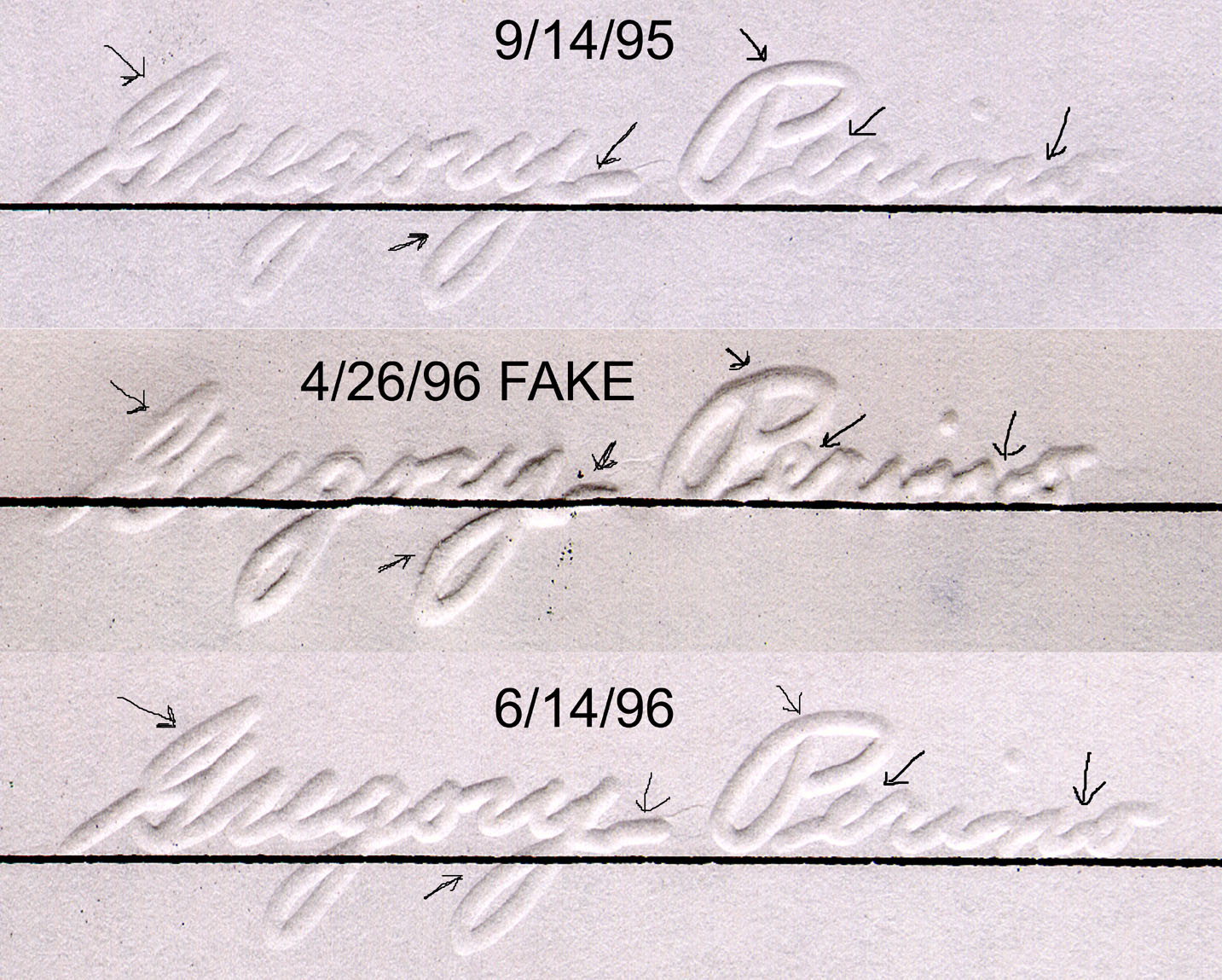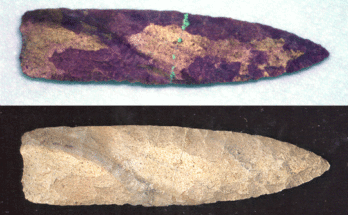BUY THE ROCK! NOT THE PAPER.
By Alexander Przygoda (originally printed 4/2003)
State of the Hobby
For too long, many artifact collectors have relied upon the opinions of others when it comes to deciding whether or not a piece is authentic. This has created a great divide amongst these collectors as they choose who they prefer to believe over another, whether it be Jackson, Perino, Davis, Berner, Fisher et al. As a result of this divide, lawsuits and public controversy have become the order of the day. Collectors and dealers with private agendas have pitted authenticator vs. authenticator in attempts to either discredit the authenticator they disagree with, or try and boost public perception of a particular authenticator’s abilities. It is becoming more and more apparent that authenticators need to base their opinions on empirical evidence and not ‘because it feels old’ or ‘I’ve never seen one made that way’.
The Importance of Microscopes
As they say in the Magic business, “Nothing is ever as it appears”, and it is the same with artifacts. Getting a good close-up look at pieces is imperative to verify authenticity nowadays as the fakers are using more and more advanced methods to try and pass pieces off on the smarter collectors. Gone are the days of the big nasty fakes. Fakers are now replicating artifacts, and then using them in the same ways the Indians would, i.e. cutting on a piece of bone, dinging the tip/sides a little. They are moving away from chemical etching and aging techniques like potassium permanganate and lye baths, and moving towards replicating mineralization, even going to the extremes of removing minerals from one piece, and gluing them onto a new one. As the fakers are getting more and more organized, sharing tips and techniques they are using to pass pieces at shows and elsewhere, knowing what is correct becomes even more important in order to spot impropriety on a piece. This information is readily available and can be self-taught from personal field finds as well as a little research on the internet and in libraries.
  Fresh crushing in a notch @ 30x |
Don’t Necessarily Believe All Papers are Correct
Not all authenticators go to the lengths that others do to prevent forgeries. It is relatively easy on certain certificates to just remove the picture of the piece and replace it with a picture of a fake made to fit the dimensions listed. There are also some forgeries out there that are so close it is scary. Many have seen the more obvious Gregory Perino forgeries, however not many are aware of the one below. The typewriter is identical and has been modified to ‘drop e’s’ etc. The embossed signature is scarily close, and would pass in a fast moving crowd. However there are some notable differences – length, slight (over) differences in the cursive, all of which are identifiable. The paper also does not match when compared via black-light analysis of papers from the same time period before and after the date printed on the certificate.

  High speed sanding striations on a ridge at 30x |
Where do We go From Here?
With such insidious methods being employed nowadays to part honest collectors from their hard-earned money, via auctions – both online and live, as well as other venues like shows and quarterly publications, it is no wonder that major collectors are far and few between. Very few new ‘Madison-Avenue’ types are willing to jump into this niche of Prehistoric Collectable due for the most part, to the sheer quantity of reproductions floating around. This also is very intimidating to new collectors. On more than one occasion, we have had the opportunity to speak with new collectors who have been corrupted by certain individuals in the industry who had perpetuated
rumors and blatant lies to the new collector about many others in this hobby. Always without proof, and always to put themselves in a position to receive most of the new collector’s business. This has a habit of eventually backfiring on the shady character, however the damage has been done and we have lost many good individuals due to the bad taste they have in their mouth for the whole hobby. The only place left for this hobby to go in the future is towards the side of honesty. More and more true-science is being applied to artifact authentication nowadays, and more and more people are learning for themselves, through the work of people like Bill Jackson.
  Helical scoring from a modern bit @ 10x |
What Should You Look For??
The most common forms of reproductions are easily spotted with simple magnification. Modern tool signatures, coatings, and other evidence of modern manufacture are easily spotted with tools like a microscope armed with good lighting. Modern tools have a tendency to create homogenous markings, whether it be parallel striations from a wire wheel, belt sander, or buffer, or score-marks from a high speed rotary coring drill bit. These tools are available in nearly every imaginable shape, taper, diameter, grit, and speed. Spend some time at the hardware store or at a machine shop sometime and examine the wide variety of tools available to an industrious faker as well as examining their signatures under a microscope. These tools do a number on materials that many think take hours to create. Creating a Bannerstone or Axe, which many thought took hours, even days of hard work, can be cranked out in mere minutes. Even scarier is the proposition of a faker cranking out dozens of unfinished blanks, and then hand finishing the pieces using what many believe to be proper construction characteristics. Coatings are another tell-tale sign of a reproduction, as you must ask yourself the question, “Why does this piece have this thick, gooey mess all over it and especially down in the notches?” The fakers have to artificially age a piece in order to sell it to most individuals. Coatings are one way in which they pursue this task. Rechipping is fast becoming the #1 favored method of reproduction/modification by the fakers, as it is far easier to expertly knap a tip or a base on a piece already loaded with proper mineralization and then just try and blend this freshly knapped area into the rest of the ‘patina’ on the point. However, rechipping, like modern tools and coatings, leaves a tell-tale fingerprint of freshly crushed flint and loose hinge fractures and later tears. Also the flaking pattern can vary drastically between the old piece and the new areas, so watch for some form of aging technique or coating even on ‘no brainer’ pieces that normally wouldn’t receive another glance. Proper mineralization and weathering is the key. No-one can beat good old mother nature when it comes to giving each item that has been in the ground a thorough once over. Not only are there natural compounds in the soil that affect pieces, but there are also microorganisms which catalyze certain elements in the ground and re-deposit them on the surface of pieces in addition to the ever-present geological decay which has been going on for eons. True deposits and surface weathering have a fingerprint all their own which is unmistakable from the fakers’ best attempts.
Who Should You Believe??
The truth of the matter, is, NO ONE except yourself! We don’t force anyone to take our word for it, however we will certainly share our opinion and why we feel a certain way and how we arrived at that opinion about a particular piece in question. Doing your due-diligence is part of being a responsible collector and fighting the fakers. This includes fighting the ‘Green Monster of Greed’ and not buying that Big, Juicy, Beautiful-yet-ridiculously-low-priced-for-the-type fake at auction or at a show! Don’t believe any story, don’t believe any provenance, nor have any preconceptions about a piece based on ‘who someone got the piece from’. We’ve seen numerous
pieces we knew were good, but the story certainly didn’t match up. Some individuals find it necessary to make up a story to go along with the rock, either through an attempt to build up their ego or to try and sell the rock, when truth is, the rock will sell itself. We’ve seen good rocks come from ‘bad’ people, and bad rocks come from ‘good’ people. It is up to you, the collector to decide what is hype, and what is right, for you.
All Text and Images Copyright © 2003 Alexander Przygoda All Rights Reserved.




